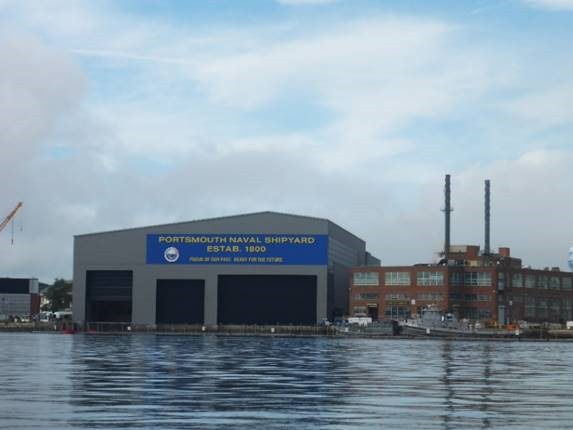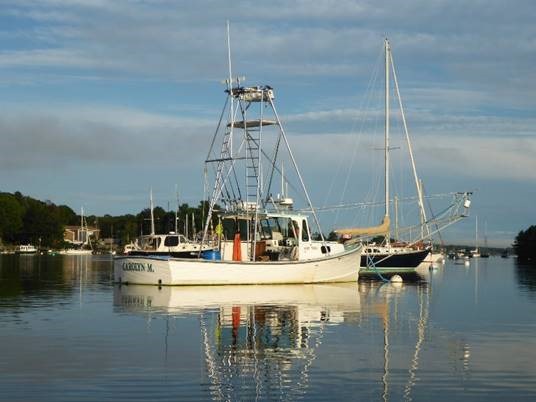20 Sep - Visiting Portsmouth New Hampshire and Gloucester Massachusetts

|
42:31.24N 070:51.9W This particular Portsmouth (there are three in the US that I have visited, plus the one in Dominica and our own Special Place) is a Navy town that straddles the Piscataqua River… note how Americans place the word ‘river’ after the name – I can’t think of an equivalent English example. Interestingly the Navy Yards (owned by the Defense Department and where they refit submarines) are on the north side of the river, in the State of Maine – so I imagine that workers there who reside in the rather attractive New Hampshire suburbs will have a complicated tax return, even with Mr Trump’s much vaunted reforms.
Looks like a dockyard, then! The highlight of our passage down from Monhegan was the sighting of a large Fin Whale. These are the second largest animal on earth after the blue whale. He wasn’t the least bit interested in us and was gone before we had the opportunity to photograph him, but the very long black body with a fairly small, well-defined dorsal fin was unmistakeable. About 50 feet long, he crossed our bow at about a quarter of a mile and headed inshore. We could not keep up, so kept going towards Portsmouth, where we picked up a buoy belonging to fellow Ocean Cruising Club members Greg and Debby Gebow off the Coastguard station at New Castle (two words – Ed).
Escapade moored off Fort Constitution, New Castle The harbour entrance here is dominated by a British fort reminiscent of the defences around Portsmouth, Hampshire, albeit on a smaller scale. The American ‘Narrows’ is much bigger though, and there’s another fort across on the Maine shoreline which is built mainly of red brick – sound familiar? New Castle is another clapboard picture postcard place: immaculate, quiet, quaint, affluent and split between lobstermen and recreational boaters. It is strung across a series of small islands, complete with boutique marinas, fine sandy beaches and a smart hotel, the Wentworth, where the negotiators for the end of the Russo-Japanese War of 1904-5 stayed when they signed the Treaty of Portsmouth. Their town planning rules seem to be fairly simple: you either renovate a Colonial style home, or you build in that manner. You can let the wood weather naturally or paint it white or pastel shades, a flagstaff seems almost mandatory and a year-round door wreath clearly signifies… something. The gardens are more English than in Virginia, with the odd picket fence but not many vegetable patches (unless it’s for pumpkins).
My favourite house in New Castle The Portsmouth Yacht Club is here and we met Greg the following morning. He’s an ex-USAF fast jet pilot who grew up to fly airliners, married Debby a cabin crew colleague and settled here. Very generously, they loaned us their car for the day and we took advantage of one of the best value, good quality grocery stores we have found on the east coast of the States to restock some of our supplies ahead of a return to the victualling challenges of the Caribbean.
Navigator confirms location of Portsmouth Yacht Club We also opened an American bank account that we can use with minimal service charges for the next nine months or so until we finally leave the western Atlantic area: it’s surprisingly easy to do this as a non-resident foreigner, although transferring money between individual accounts is really complicated. Overall, we’ve found the US banking system to be quite variable: they cite concerns over fraud when defending their hideously complex transfer arrangements, yet nobody uses a PIN when using a card to purchase stuff over the counter. Instead, you ‘sign’ your name with your index finger… just try it for a moment if you haven’t done so before – it’s laughably inept.
Downtown New Castle We had a good look around Portsmouth itself, which is a tourist destination well known for its restaurants and some interesting social history of the early settlers but it’s not really a ‘waterfront town’. The inhabitants managed to burn it down three times, so today’s architecture has more Victorian red brick buildings than we’ve seen elsewhere. It’s a nice place to live and work and probably a good base for touring the surrounding area, but we limited ourselves to a nose round the shops and an enjoyable ride in the rubber boat around the harbour and its archipelago of islands. Greg and Debby hosted us for a memorable sundowners session at the Yacht Club which bears some similarities with Hornet: some pontoons, some moorings, a fine wooden clubhouse at the water’s edge with all the facilities but no winter storage area and critically no ‘house’ staff to run the bar and galley, so the Members have lockers full of alcohol rather than lifejackets in the entrance hall!
This former lobster boat has been converted into a bluefin tuna chaser with a harpoon in the bow… We spent most of Tuesday 18th at the buoy whilst the remnants of Hurricane Florence dumped gallons of water on us – not much wind by now, but a couple of months- worth of rain in a day.
The bridge across the Piscataqua has an interesting memorial inscription: their war ended late, apparently without any airmen. On Wednesday we sailed – with the wind on the beam – to Gloucester in Massachusetts. Gloucester is a major fishing port with a long history of deep sea fishing and lobstering. In the late 1990s the town came to international prominence in the aftermath of a dreadful winter storm during which the fishing vessel Andrea Gail was lost with all hands. The story was immortalised in a brilliant book by Sebastian Junger called ‘The Perfect Storm’. My father recommended it to me at the time and it has had a lasting impact on me as a seafarer and an individual. Hollywood made a pretty good film of it starring George Clooney as the skipper Billy Tyne and we were keen to see the town, the famous Fishermens Memorial (which records the names of several thousand Gloucestermen lost at sea over the last four centuries) and the Crow’s Nest bar where the crew of the Andrea Gail used to relax. We followed their lead whilst the laundry did its thing; the bar is very unassuming, friendly, frequented by fishermen and their families and run by the same people who were here in the 90s. There’s a discrete memorial to the Andrea Gail and a couple of pictures of Gorgeous George with the bar staff if you know where to look, but no attempt to cash in on the fame from the movie. Quite right too: that was a very personal tragedy that affected the lives of those who were left behind forever. Further along the seafront, in front of fine houses probably built by rich trawler owners and successful sea captains, there’s a beautifully tended promenade and a fine memorial to the men lost at sea – and another recognising the women and children left behind. Very sobering to see the horrendous losses in the second half of the nineteenth century and I saw the names of Gloucestermen lost in the 1851 Yankee Gale which I wrote about in the last blog: an awkward reminder that progress in safety at sea only comes as the result of tragic loss, not as a pre-emptor.
Gloucester Fishermens Memorial From Gloucester, we had another short sail down to Salem, threading our way between a barrier of islands, isolated rocks, shoals and interesting tidal streams – great sailing, but we were grateful for the assistance from GPS and electronic navigation. I wondered about our predecessors, the value of local knowledge and the skills that were necessary to manoeuvre sluggish, unpredictable ships without engines or much upwind capability in these waters without decent charts or weather forecasting. Modern society owes those remarkable seafarers a great deal…
Gloucester Fishermens’ Wives Memorial – a fine tribute to their terrific support
Gosport, Isles of Shoals, New Hampshire |









